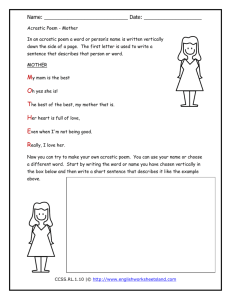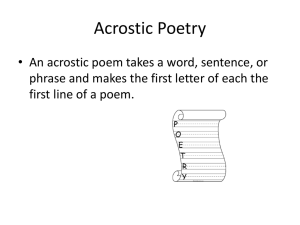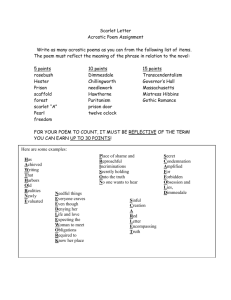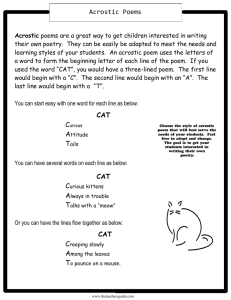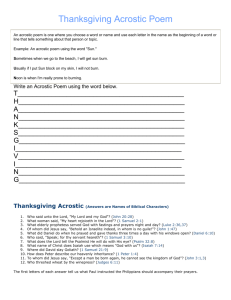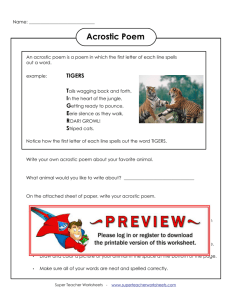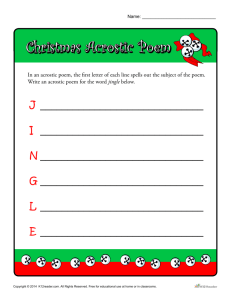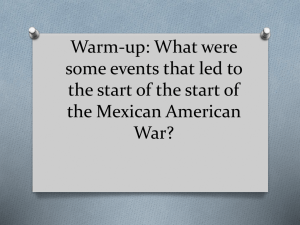Wetlands Acrostic Poem
advertisement
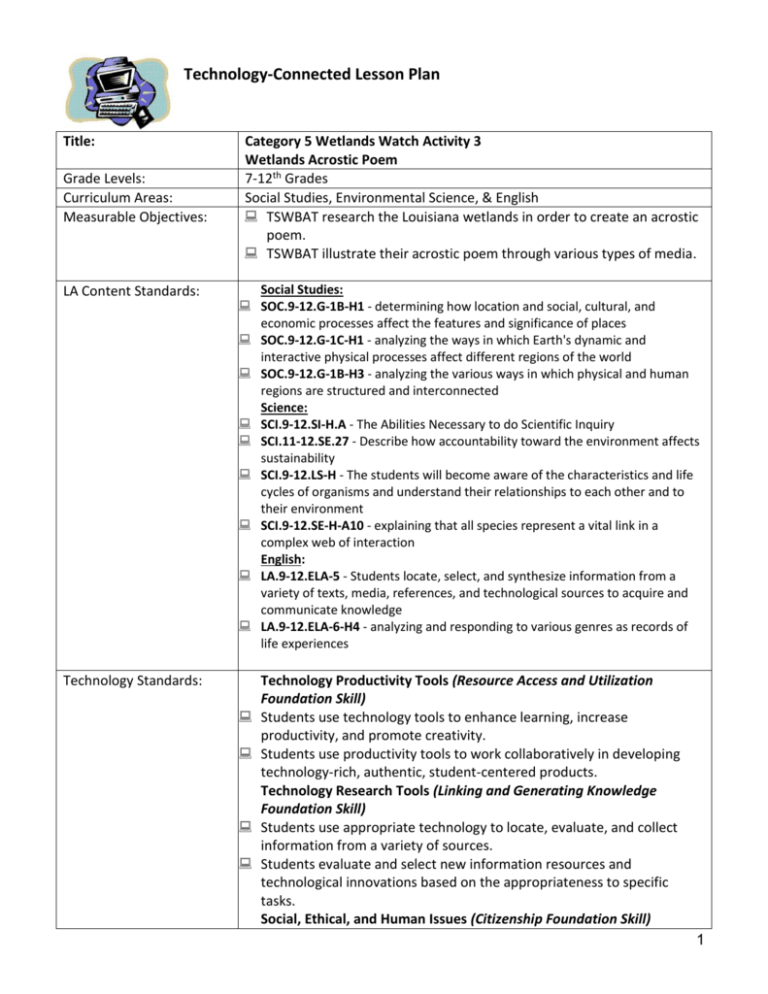
Technology-Connected Lesson Plan Title: Grade Levels: Curriculum Areas: Measurable Objectives: LA Content Standards: Category 5 Wetlands Watch Activity 3 Wetlands Acrostic Poem 7-12th Grades Social Studies, Environmental Science, & English TSWBAT research the Louisiana wetlands in order to create an acrostic poem. TSWBAT illustrate their acrostic poem through various types of media. Technology Standards: Social Studies: SOC.9-12.G-1B-H1 - determining how location and social, cultural, and economic processes affect the features and significance of places SOC.9-12.G-1C-H1 - analyzing the ways in which Earth's dynamic and interactive physical processes affect different regions of the world SOC.9-12.G-1B-H3 - analyzing the various ways in which physical and human regions are structured and interconnected Science: SCI.9-12.SI-H.A - The Abilities Necessary to do Scientific Inquiry SCI.11-12.SE.27 - Describe how accountability toward the environment affects sustainability SCI.9-12.LS-H - The students will become aware of the characteristics and life cycles of organisms and understand their relationships to each other and to their environment SCI.9-12.SE-H-A10 - explaining that all species represent a vital link in a complex web of interaction English: LA.9-12.ELA-5 - Students locate, select, and synthesize information from a variety of texts, media, references, and technological sources to acquire and communicate knowledge LA.9-12.ELA-6-H4 - analyzing and responding to various genres as records of life experiences Technology Productivity Tools (Resource Access and Utilization Foundation Skill) Students use technology tools to enhance learning, increase productivity, and promote creativity. Students use productivity tools to work collaboratively in developing technology-rich, authentic, student-centered products. Technology Research Tools (Linking and Generating Knowledge Foundation Skill) Students use appropriate technology to locate, evaluate, and collect information from a variety of sources. Students evaluate and select new information resources and technological innovations based on the appropriateness to specific tasks. Social, Ethical, and Human Issues (Citizenship Foundation Skill) 1 Technology Connection: Procedures: Students practice responsible use of technology systems, information, and software. Students develop positive attitudes toward technology uses that support lifelong learning, collaboration, personal pursuits, and productivity. SmartBoard w/Computer w/Internet Access Access to the Category 5/Wetlands Watch videos via the TPSS ftp site. http://www.categoryfivewetlandswatch.org/ Access to the TPSS FTP site for video download. Additional Resources: http://www.readwritethink.org/classroom-resources/studentinteractives/acrostic-poems-30045.html Printer **Introduce the website for Category Five/Wetlands Watch to the students and discuss how to navigate it. The videos will be blocked, but have been downloaded to the TPSS FTP site for teacher download. Make sure that you save the video to your computer instead of streaming it directly from the FTP site.** Response Activity: Provide students with the KWL chart attached. Have the students write all the things they know about the Louisiana wetlands in the “K” column. As a class, discuss the results of this activity. Procedures: 1. Connect to the Category 5/Wetlands Watch site and open the link for “Episodes”. (http://category5wetlandswatch.wordpress.com/episodes/) 2. Show the second video to the students from 12.00 minutes in to 17.17 minutes and then stop the video. The students should take notes on the information regarding the issues discussed. 3. Have students break into groups of 2 students per group. In these groups the students will discuss what they want to learn and fill out the middle column of their KWL chart. They will then use textbooks, library research materials, and the internet to find the answers to the questions they recorded on their charts and fill those answers in on the final column. 4. The students will then need to work at a computer with print capabilities to create their acrostic poem. They should open the website http://www.readwritethink.org/classroom-resources/studentinteractives/acrostic-poems-30045.html and click the “get started” button. Students will follow the steps involved in creating their acrostic poem using the Read Write Think website. They will use their research as a starting place for the poems. Once the poems are complete the students should print two copies of their work. 5. The students will need a poster board, colored pencils, and access to a computer & printer for research. They will attach a copy of their acrostic poem in the center of the poster board and will use illustrate the poem using collage, drawings, pictures that they have taken, paintings, etc. 6. Once the partners complete their posters they will share their work with the class. These posters should be displayed around the classroom. Closure: Discuss one new thing that you learned while researching the Louisiana wetlands and creating your acrostic poem. 2 Materials: Assessment: Teacher’s Name: School: Pencil and paper Tape or glue, poster board, colored pencils, markers, etc… Class participation, poems, posters, Q & A, Closure activity. Lesson plan created by Aimee Bancroft C.M. Fagan 3 Name:________________________________________ Date:____________ Class___________ Louisiana Wetlands KWL Chart What I Know What I Want to Know What I’ve Learned 4
